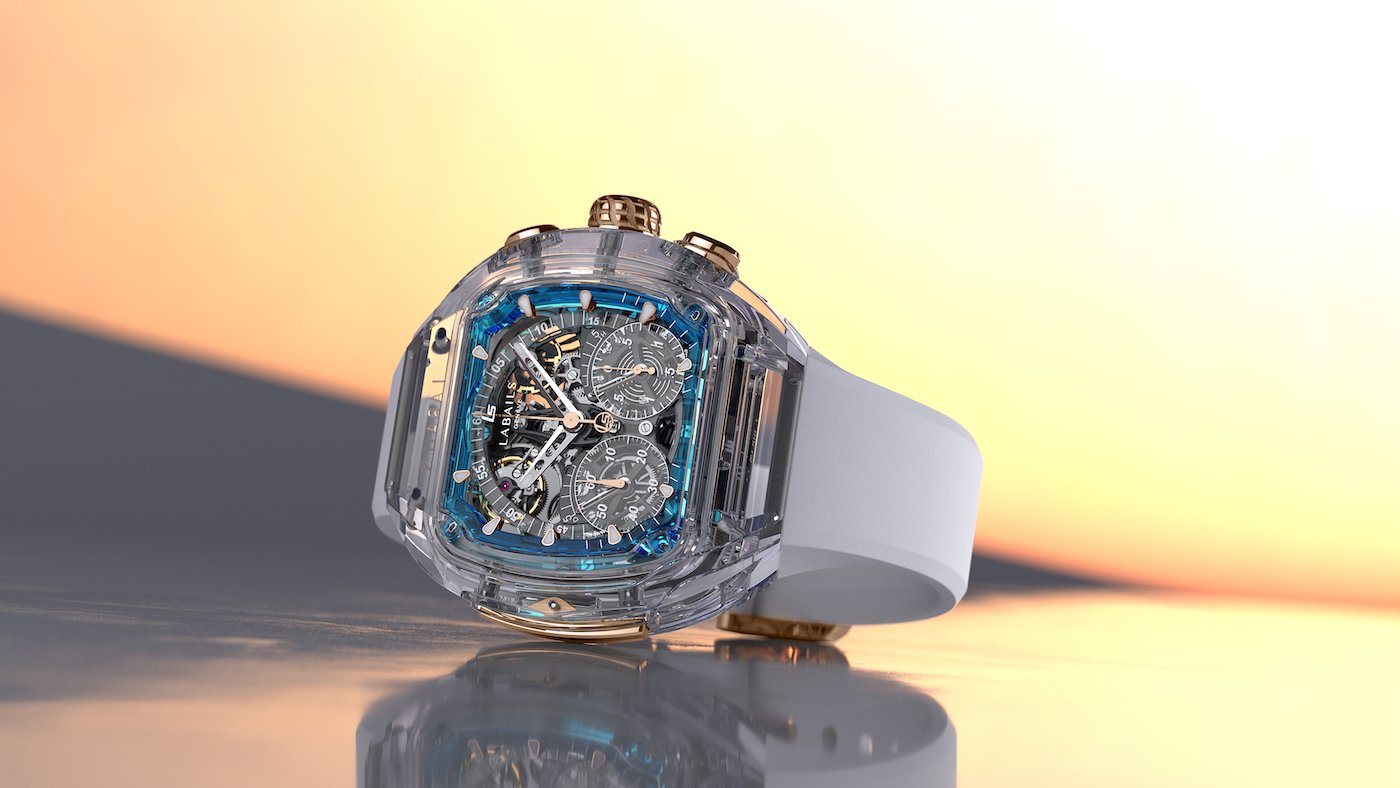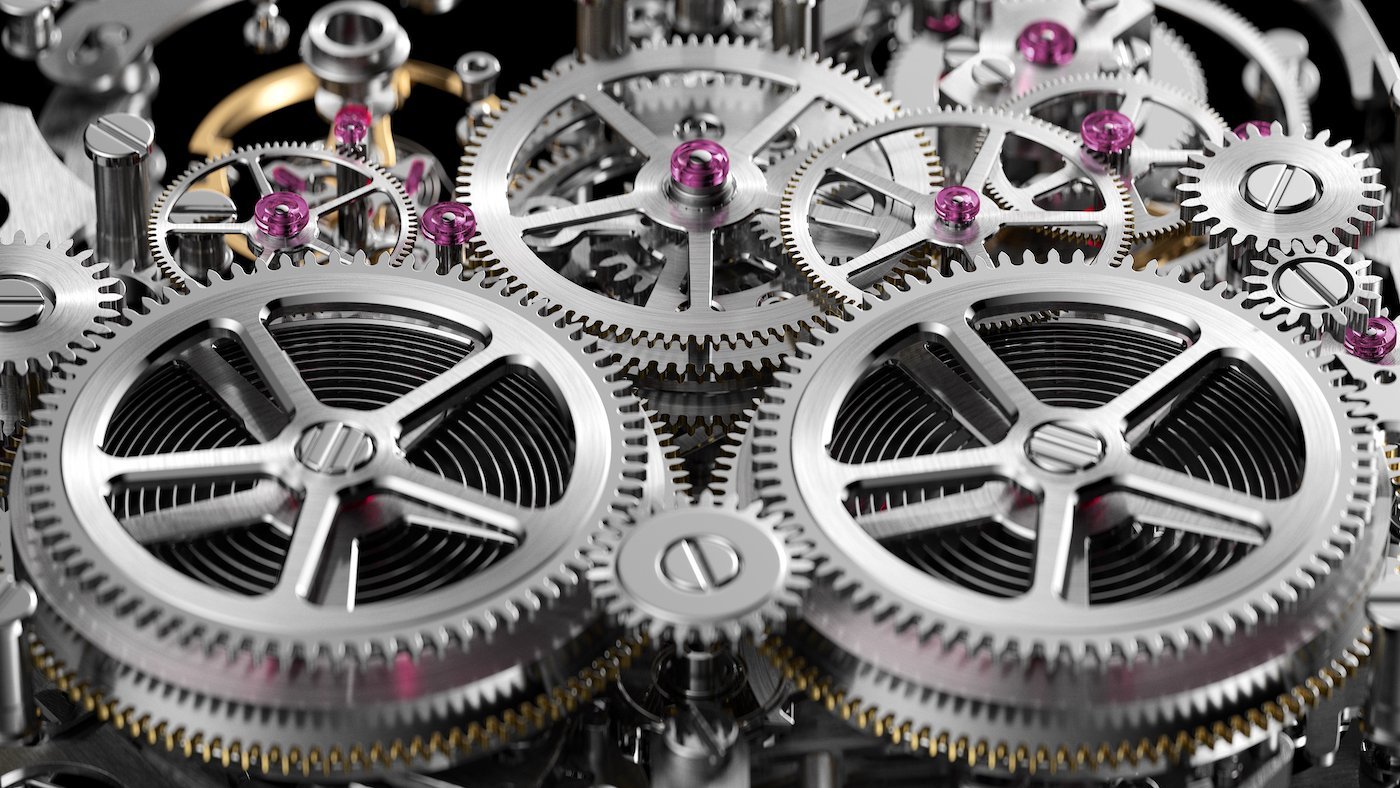ow does an aeronautical engineer specialising in turbojets come to high-mech watchmaking and create a brand whose products shoot past the two million mark? “Out of an intellectual interest in physics and mechanical engineering, and an appreciation of artistic beauty,” answers Alexandre Labails. “It was never a foregone conclusion. I grow up in an ordinary family; there were no luxury watches.”
The story begins in 2016 with a competition for staff at the engineering consultancy where Alexandre Labails worked as an industrial project manager (for the likes of Airbus). The prize was a €5,000 gift certificate for a watch. More interested in the challenge than the idea of a luxury timepiece, he entered the competition… and won.
-

- In 2016, at the age of 25, Alexandre Labails discovered watchmaking and quit his job to embark on a new project to build his own brand. This French aeronautical engineer, who hails from a family of musicians and artists, aspires to create some of the most exceptional watches anywhere.
After his boss declined to swap the prize for something else, he started browsing through the watches available in this price range, eventually picking out a Panerai. More importantly, he “came face to face with a new passion” that appealed as much to his professional interest in precision engineering as his creative streak - part and parcel of belonging to a family of musicians and artists. A watch, he discovered, was both “technical and emotional”.

He read up on the subject, jumping straight in with the Traité de Construction Horlogère and getting to grips with the mechanical intricacies of a watch. Nine months later he told his boss he was setting up his own watch brand.
At just turned 30, Alexandre Labails is nothing if not methodical. He spent the first year of his new endeavour researching the market, “from Daniel Wellington to Greubel Forsey,” with no preconceived idea as to the positioning of his future brand.
“Little by little, my project took on a dimension I hadn’t imagined,” he confesses. “I didn’t set out to build one of the most expensive watches on the market. This was about introspection, knowing who I was and what I could bring. My initial idea was to focus on the exterior design and use a Vaucher Manufacture movement.”
Encounters bring opportunities; among the suppliers he contacted in early 2018 was Jean-François Mojon, director of Chronode, one of the most highly regarded movement development consultancies. Another key player would be designer Benjamin Muller, founder of Luxury Concept Development in Geneva. The three men met in Besançon to discuss creative avenues for the brand Alexandre Labails had imagined.
-

- Temerity, the brand’s first timepiece, incorporates a low-frequency tourbillon, a high-frequency chronograph and an exclusive Energy Management Optimization System.
“One of the designs that caught my eye was the Epic X by Jacob & Co. Certain Louis Moinet watches also stood out,” says Labails. “They were all by Benjamin Muller. I felt we were coming from the same place, creatively speaking, and that we should build on that. So I put all my earlier ideas aside to start again on what would be, from the outset, a collaborative project.”
This was when his concept radically changed. “I took the decision not to set any limits of time, complexity or cost. Deep down, I wanted to create something exceptional, at the pinnacle of Haute Horlogerie, because I had the right support.”

The first model, the aptly named Temerity, only ten of which will be made, arose from the desire to take a complication to its furthest reaches. Traditional and contemporary, it reflects the two sides, technical and artistic, of Alexandre Labails’ personality.
The question then became, which area of watchmaking should he focus on? “The standout complication in sport is the chronograph. How can you improve the chronograph? My idea was to work with high frequency to measure shorter elapsed times, except high frequency drains power from the movement and, in the longer term, can have a negative impact on the watch’s primary function of timekeeping, when the two are connected.”
The eternal dilemma of performance versus power. The usual solution is to have separate kinematic chains: one for the primary timekeeping function and a second for the chronograph. “Except this takes up room in an already confined space. More to the point, this type of construction keeps back power for a secondary function that is only occasionally used.”
-

- In Eco (energy-saving) mode, power is supplied only to the primary timekeeping function. The high-frequency kinematic chain is deactivated, hence its balance wheel is immobile. In Sports mode, power is supplied to the primary function and to the secondary function. The high-frequency balance wheel is operative so that the chronograph can be used.
“This is where our innovation comes in,” Labails explains. The solution? “A single source of power, from twin barrels, that lets the user switch between Eco mode and Sports mode, not unlike in a car. We’ve designed a unique construction with two kinematic chains in one. The first is for the hours-minutes function and the second, optional one is for the high-frequency chronograph. This construction is managed through an innovative and exclusive Energy Management Optimization System.”
The user “allocates” power via a gear switch at 9 o’clock.
In Eco mode, the hours-minutes function is regulated by a balance wheel oscillating at 3Hz, inside a tourbillon that makes one rotation per minute. “So as to avoid possible disparities in inertia when adjusting the regulating organ, we have opted for a variable inertia balance with four gold adjustment screws. We’ve added a stop-seconds mechanism to the tourbillon so the time can be precisely set by referring to a marker on the tourbillon cage.”
In Sports mode, which corresponds to the chronograph function, a high-frequency regulator oscillating at 10Hz enables elapsed times to be displayed with five-hundredths of a second precision. The regulator oscillates ten times per second. This means the escape wheel changes position 20 times a second or 72,000 times an hour; in other words, once every five-hundredths of a second.
Readoff is by three hands on three separate dials: one for jumping minutes, one for seconds and one for five-hundredths of a second. The latter is divided into three one-second segments, meaning the hand indicating the five-hundredths of a second rotates at an angular speed of 120°/second.
Even with a high-frequency chronograph, because the movement is designed for optimal energy management via the patent-pending Energy Management Optimization System, and has twin barrels, the Temerity delivers up to five days of power reserve for the primary timekeeping function.
-

- In order to maintain sufficient power for the timekeeping function, when power reserve reaches 24 hours, the high-frequency kinematic chain is automatically stopped.
The comparison with the automotive world continues in the Temerity’s aerodynamic hypercar design. “Benjamin Muller played a crucial role in helping my idea see daylight,” says Alexandre Labails. “He was able to transport himself into my creative world. The level of finishing is truly artistic, and I don’t use the word lightly. It takes between 100 and 200 hours just to decorate the more than 550 parts in the movement.”
The choice of materials underscores this hyperwatch’s supercharged personality, with bridges and main plate in titanium in addition to a sapphire case, sourced from a specialist supplier in Le Locle. “Sapphire is notoriously difficult to machine. Usually, a collection builds up to sapphire whereas we took the opposite stance and started with sapphire. As newcomers, we have to make an impact. Versions in metal will come later.”
Labails, who describes himself as “a pragmatic go-getter”, put up the seed capital for the company himself, fully aware that such an ambitious project would require investments of several million in research and development. The first capital increase was raised through outside investors in 2020. “The fact I’d invested my own money over the first three years reassured them and opened certain doors.”
The conception stage for a personalised model will take between 24 and 36 months. Assembly will initially be at Chronode, with the aim of gradually integrating a certain number of specialisms.
The CHF 2.2 million price tag is the consequence of the decision to make no compromises and impose no limits on R&D. “We can choose to push the needle, or not, at different stages in conception, such as the level of finishing. We set all the needles at the maximum.”
Such a price level will necessarily be a major barrier to entry for many; Alexandre Labails has opted to clearly state the amount upfront so that customers are fully informed. In any event, sales are made not through traditional distribution but via direct enquiries and recommendations, a method more suited to this type of clientele.
“The customer typology that we are targeting is in the habit of buying exceptional products, including when this means a waiting time of several years. We address maybe 2,000 potential clients worldwide, who already own a superlative watch collection, out of 200,000 people with the capacity to purchase our watch. The first customers must fall in love with the product and with the project. They must want to be part of the genesis of an exceptional brand.”
SPECIFICATIONS
MOVEMENT
- Dimensions (l x w x h): 32 x 36.25 x 11.6mm
- Weight: 20.68g
- Number of parts: 551
- Tourbillon cage: 35 parts, 0.38g
- Number of jewels: 65; polished and bevelled jewel holes
Hours & minutes:
- Regulating organ: 60-second Tourbillon with stop-seconds, 3Hz regulating organ (21,600 vib/h; 8.30mm diameter; Incabloc shock protection), variable-inertia balance wheel with gold adjustment screws
- Hands: rhodium-plated with Super-Luminova; chamfered, polished, satin-finished
- Rehaut: sky-blue yttrium aluminium garnet; polished
- Indexes: rose gold (18K) with Super-Luminova
Chronograph:
- Regulating organ: high-frequency regulating organ (10Hz / 72,000 vib/h; 8mm diameter; Incabloc shock protection) with two stop-second systems, variable-inertia balance wheel with gold adjustment screws
- Chronograph function (start/stop/reset): three dials and three hands: jumping minutes, seconds, 0.05 seconds
- Dials: sapphire; polished, engraved, lacquered
- Hands: aluminium (density 2.7); rose-gold-plated, satin-finished
Energy management:
- Energy source: two parallel barrels with slipping springs to prevent excess tension
- Manual winding
- Energy Management Optimization System with two modes (Eco & Sports)
- Fast-rotating barrels: 1 rotation in 24 minutes in Sports mode
- Power reserve: up to 120 hours (full Eco mode)
- Chronograph power reserve: up to 5 hours (full Sports mode)
- Two adaptive power-reserve indicators
- Power-reserve safety system activated when power reserve reaches 24 hours
Bridges & main plate:
- Titanium
- Microblasted, satin-finished, polished bevelling, polished
Gears:
- Involute profile
- Circular satin-finished, rhodium plated, polished bevelling, polished
CASE
- Dimensions (l x w x h): 51.95 x 48 x 16.8 mm
- Water-resistance: 5 ATM
- Full sapphire case: polished, laser engravings
- Crown: rose gold (18K) and sapphire; polished, microblasted, laser-engraved logo
- Pushers and gear switch: rose gold (18K); polished, microblasted
- Sapphire crystals with anti-reflective treatment on both sides
STRAP
- Material: FKM
- Width: 20 mm
- Titanium inserts
- Pin buckle: rose gold (18K); polished, satin-finished, microblasted
PRICE
- CHF 2,200,000



























































